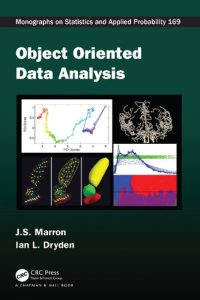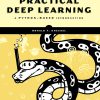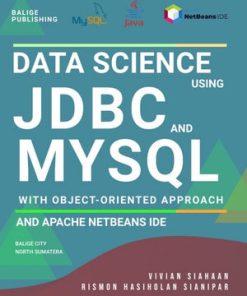Object Oriented Data Analysis 1st Edition by J. S. Marron, Ian L. Dryden 9781351189651 1351189654
$50.00 Original price was: $50.00.$25.00Current price is: $25.00.
Object Oriented Data Analysis 1st Edition James Stephen Marron – Ebook Instant Download/Delivery ISBN(s): 9780815392828,9781351189675,0815392826,1351189670

Product details:
- ISBN 10: 1351189654
- ISBN 13: 9781351189651
- Author:J. S. Marron, Ian L. Dryden
Object Oriented Data Analysis
Table contents:
1 What Is OODA?
1.1 Case Study: Curves as Data Objects
1.2 Case Study: Shapes as Data Objects
1.2.1 The Segmentation Challenge
1.2.2 General Shape Representations
1.2.3 Skeletal Shape Representations
1.2.4 Bayes Segmentation via Principal Geodesic Analysis
2 Breadth of OODA
2.1 Amplitude and Phase Data Objects
2.2 Tree-Structured Data Objects
2.3 Sounds as Data Objects
2.4 Images as Data Objects
3 Data Object Definition
3.1 OODA Foundations
3.1.1 OODA Terminology
3.1.2 Object and Feature Space Example
3.1.3 Scree Plots
3.1.4 Formalization of Modes of Variation
3.2 Mathematical Notation
3.3 Overview of Object and Feature Spaces
3.3.1 Example: Probability Distributions as Data Objects
4 Exploratory and Confirmatory Analyses
4.1 Exploratory Analysis–Discover Structure in Data
4.1.1 Example: Tilted Parabolas FDA
4.1.2 Example: Twin Arches FDA
4.1.3 Case Study: Lung Cancer Data
4.1.4 Case Study: Pan–Cancer Data
4.2 Confirmatory Analysis–Is It Really There?
4.3 Further Major Statistical Tasks
5 OODA Preprocessing
5.1 Visualization of Marginal Distributions
5.1.1 Case Study: Spanish Mortality Data
5.1.2 Case Study: Drug Discovery Data
5.2 Standardization–Appropriate Linear Scaling
5.2.1 Example: Two Scale Curve Data
5.2.2 Overview of Standardization
5.3 Transformation–Appropriate Nonlinear Scaling
5.4 Registration–Appropriate Alignment
6 Data Visualization
6.1 Heat-Map Views of Data Matrices
6.2 Curve Views of Matrices and Modes of Variation
6.3 Data Centering and Combined Views
6.4 Scatterplot Matrix Views of Scores
6.5 Alternatives to PCA Directions
7 Distance Based Methods
7.1 Fréchet Centers In Metric Spaces
7.2 Multi-Dimensional Scaling For Object Representation
7.3 Important Distance Examples
7.3.1 Conventional Norms
7.3.2 Wasserstein Distances
7.3.3 Procrustes Distances
7.3.4 Generalized Procrustes Analysis
7.3.5 Covariance Matrix Distances
8 Manifold Data Analysis
8.1 Directional Data
8.2 Introduction to Shape Manifolds
8.3 Statistical Analysis of Shapes
8.4 Landmark Shapes
8.4.1 Shape Tangent Space
8.4.2 Case Study: Digit 3 Data
8.4.3 Case Study: DNA Molecule Data
8.4.4 Principal Nested Shape Spaces
8.4.5 Size-and-shape space
8.4.6 Further Methodology
8.5 Central Limit Theory on Manifolds
8.6 Backwards PCA
8.7 Covariance Matrices as Data Objects
9 FDA Curve Registration
9.1 Fisher-Rao Curve Registration
9.1.1 Example: Shifted Betas Data
9.1.2 Introduction to Warping Functions
9.1.3 Fisher-Rao Mathematics
9.2 Principal Nested Spheres Decomposition
10 Graph Structured Data Objects
10.1 Arterial Trees as Data Objects
10.1.1 Combinatoric Approaches
10.1.2 Phylogenetics
10.1.3 Dyck Path
10.1.4 Persistent Homology
10.1.5 Comparison of Tree Analysis Methods
10.2 Networks as Data Objects
10.2.1 Graph Laplacians
10.2.2 Example: A Tale of Two Cities
10.2.3 Extrinsic and Intrinsic Analysis
10.2.4 Case Study: Corpus Linguistics
10.2.5 Labeled versus Unlabeled Nodes
11 Classification–Supervised Learning
11.1 Classical Methods
11.2 Kernel Methods
11.3 Support Vector Machines
11.4 Distance Weighted Discrimination
11.5 Other Classification Approaches
12 Clustering–Unsupervised Learning
12.1 K-Means Clustering
12.2 Hierarchical Clustering
12.3 Visualization Based Methods
12.3.1 Hybrid Clustering Methods
13 High-Dimensional Inference
13.1 DiProPerm–Two Sample Testing
13.2 Statistical Significance in Clustering
13.2.1 High Dimensional SigClust
14 High Dimensional Asymptotics
14.1 Random Matrix Theory
14.2 High Dimension Low Sample Size
14.3 High Dimension Medium Sample Size
15 Smoothing and SiZer
15.1 Why Not Histograms?–Hidalgo Stamps Data
15.2 Smoothing Basics–Bralower Fossils Data
15.3 Smoothing Parameter Selection
15.4 Statistical Inference and SiZer
15.4.1 Case Study: British Family Incomes Data
15.4.2 Case Study: Bralower Fossils Data
15.4.3 Case Study: Mass Flux Data
15.4.4 Case Study: Kidney Cancer Data
15.4.5 Additional SiZer Applications and Variants
16 Robust Methods
16.1 Robustness Controversies
16.2 Robust Methods for OODA
16.2.1 Case Study: Cornea Curvature Data
16.2.2 Case Study: Genome-Wide Association Data
16.3 Other Robustness Areas
17 PCA Details and Variants
17.1 Viewpoints of PCA
17.1.1 Data Centering
17.1.2 Singular Value Decomposition
17.1.3 Gaussian Likelihood View
17.1.4 PCA Computational Issues
17.2 Two Block Decompositions
17.2.1 Partial Least Squares
17.2.2 Canonical Correlations
17.2.3 Joint and Individual Variation Explained
18 OODA Context and Related Areas
18.1 History and Terminology
18.2 OODA Analogy with Object-Oriented Programming
18.3 Compositional Data Analysis
18.4 Symbolic Data Analysis
18.5 Other Research Areas
People also search:
object oriented data analysis
root — an object oriented data analysis framework
object oriented data analysis pdf
object oriented data analysis python
object oriented data analysis sets of trees
You may also like…
Computers - Databases
Computers - Programming
Grokking the Object Oriented Design Interview 1st Edition by Educative.Io
Computers - Programming
Education Studies & Teaching - Education - General & Miscellaneous
Science (General)
Computers - Programming
Object Oriented Python 1st editon by Irv Kalb 1718502079 9781718502079
Computers - Programming
The Object Oriented Thought Process 5th Edition Matt Weisfeld
Computers - Programming
Computers - Programming












